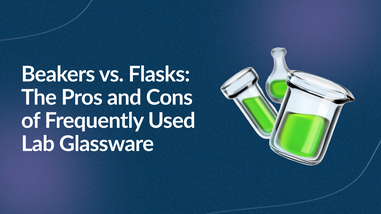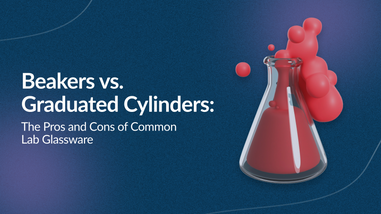- No products in the cart.
What is a pipette?
A pipette is a type of media dispenser used to transfer specific volumes of liquid.
Pipettes are often used as a ubiquitous symbol of lab work and science, and while they are a commonly found item in nearly any laboratory, there are various types of pipettes that each require specific guidelines with regard to use and maintenance. Pipettes can range from disposable plastic pipettes to higher-grade, more technical pipettes; and serve a variety of different purposes with varying levels of precision. These include:
- Graduated pipettes
- Serological pipettes
- Pasteur pipettes
- Volumetric pipettes
- Micropipettes
Pipette Calibration
A pipette is a laboratory tool - and like many other tools that are used to measure or produce data, it needs to be calibrated to ensure it is working within expected standards.

What does it mean to calibrate a pipette?
The calibration process checks whether or not the equipment is dispensing the proper volumes by determining the difference between the dispensed volume and the selected volume. Calibration ensures accuracy, and the process and steps vary between pipette type and model.
Atmospheric pressure, humidity, and temperature can all influence measurement accuracy over time. In the calibration process, the combination of these factors generates a Z factor, which can be applied in the calculation of water volume to determine pipette accuracy.
Pipettes should be calibrated every 3-6 months as recommended by the Clinical and Laboratory Standards Institute (CSLI). This refers to single and multi-channel pipettes, as well as automated pipettes. Pipettes can be sent to companies that specifically service for recalibration.
Graduated Pipettes
Graduated pipettes refer to various types of macro pipettes that are classified by a sequence of graduations to show different volumes. These pipettes include other variations and require a type of suction to transfer the liquid.
When choosing a graduated pipette, the recommendation is for the nearest size pipette to the liquid volume that is needed to work with. Rinse the pipette before use. Hold the pipette tip in the solution that needs to be transferred at a 90-degree angle without touching the bottom of the beaker. Then, use the rubber or plastic bulb to slowly draw the liquid in until the desired volume has been reached. During the process, the pipette must be held upright. The solution will form a meniscus (curved upper surface of the liquid in the tube). To properly read the volume, look at the meniscus at eye level. For low viscosity liquids, the volume is measured at the lower meniscus. For high viscosity liquids, the volume is measured at the upper meniscus. The solution should be dispersed by releasing the pressure and holding the pipette at a 45-degree angle.
Serological Pipettes
A serological pipette is a type of graduated pipette used for transferring liquid in milliliter volumes and is determined by its graduation marks that start closer to the tip. Serological pipettes are blow-out pipettes, which are pipettes that are designed to be blown out by either external air pressure or gravitation force. Serological pipettes can come in different sizes, from 0.1 ml to 50 ml, and are available in bulk. Serological pipettes like these are manufactured from optically clear polystyrene and along with being calibrated for accuracy, they are gamma irradiation sterilized.
Pasteur Pipettes
In the 19th century, Louis Pasteur redesigned basic glass pipettes to make them more efficient. Over a hundred years later, Pasteur pipettes are still used to transfer liquids. These types of pipettes are typically made of glass or plastic, with a rubber bulb separate from the pipette body to control the flow of liquid. Pasteur pipettes are used to transfer small volumes of liquids and are not calibrated or marked with any volumetric guidelines.
Volumetric Pipettes
Volumetric pipettes allow for precise accuracy. Volumetric pipettes have long slender necks above and below a large bulb, with one graduation mark. Volumetric pipettes are calibrated for single volumes typically ranging from 1, 5, 10, 20, 25, 50, and 100 ml and are made from borosilicate glass. Borosilicate glass is a favorite among professionals as its natural properties defend against mechanical stress, chemicals, and thermal shift.
Micropipettes
Micropipettes are used for transferring extremely small quantities of liquid from 0.5 μL to 1000 μL. Micropipettes come in different sizes for different volumes of liquid, and both variable and fixed pipettes correspond with a volume bracket.
Each variety also requires specific pipette tips. Tips should be changed out between use to prevent cross-contamination.
Pipette Type Volume (μL)
P10 0.5–10
P20 2–20
P200 20–200
P1000 200–1000
P5000 1000–5000
Lab Pro’s variable volume pipettes come in different volume sizes, and have built-in tip ejectors and autoclavable tip cones, along with a certificate of calibration. Their fixed volume pipettes also contain autoclavable tips, and are available in a wide range of volume capacities with low cost and very high accuracy.
For over 40 years, Lab Pro Inc. has been committed to delivering the highest quality pipettes, laboratory equipment and cleanroom PPE supplies to medical device and electronic manufacturing laboratories worldwide. To learn more, visit the biggest Lab Supply showroom in California, or contact us online or at 888-452-2776.












































